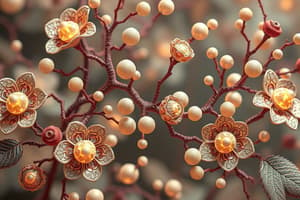Podcast
Questions and Answers
What is the primary factor determining whether a substance has beneficial effects or becomes toxic?
What is the primary factor determining whether a substance has beneficial effects or becomes toxic?
- Time period of exposure to the substance
- Chemical structure of the substance
- Concentration or dose of the substance (correct)
- Rate of absorption in the body
What does the therapeutic index (TI) evaluate in drug administration?
What does the therapeutic index (TI) evaluate in drug administration?
- The purity of the drug compound
- The ratio of LD50 to ED50 or TD50 to ED50 (correct)
- The duration of the drug's effects
- The maximum effect of a drug on a target
At high concentrations, which receptor type does angiotensin II primarily bind to, leading to the inhibition of vasoconstriction?
At high concentrations, which receptor type does angiotensin II primarily bind to, leading to the inhibition of vasoconstriction?
- ATR Type 1 Receptor
- ATR Type 2 Receptor (correct)
- ATR Type 3 Receptor
- ATR Type 4 Receptor
What does the term LD50 represent in pharmacology?
What does the term LD50 represent in pharmacology?
Which of the following substances can lead to toxicity at high concentrations, despite being beneficial at lower doses?
Which of the following substances can lead to toxicity at high concentrations, despite being beneficial at lower doses?
In the context of therapeutic index, what does a low TI indicate?
In the context of therapeutic index, what does a low TI indicate?
What is the consequence of a drug having a large therapeutic index?
What is the consequence of a drug having a large therapeutic index?
What type of antagonism can be directly defined as one substance acting to counteract the effects of another substance?
What type of antagonism can be directly defined as one substance acting to counteract the effects of another substance?
Which type of agonist can produce a maximum biological response at certain doses?
Which type of agonist can produce a maximum biological response at certain doses?
What is the primary characteristic of a partial agonist?
What is the primary characteristic of a partial agonist?
How is the therapeutic index defined in pharmacology?
How is the therapeutic index defined in pharmacology?
Which scenario best describes pharmacokinetic antagonism?
Which scenario best describes pharmacokinetic antagonism?
What does EC50 represent in pharmacological terms?
What does EC50 represent in pharmacological terms?
What aspect of drug selectivity refers to the ability of a drug to produce a particular effect based on its molecular structure?
What aspect of drug selectivity refers to the ability of a drug to produce a particular effect based on its molecular structure?
How does drug promiscuity potentially benefit pharmacology?
How does drug promiscuity potentially benefit pharmacology?
What defines drug potency in relation to its effect?
What defines drug potency in relation to its effect?
In what scenario might a drug with high selectivity cause unintended harmful effects?
In what scenario might a drug with high selectivity cause unintended harmful effects?
What is indicated by a high therapeutic index of a drug?
What is indicated by a high therapeutic index of a drug?
Which statement exemplifies physiological antagonism in pharmacology?
Which statement exemplifies physiological antagonism in pharmacology?
What factor primarily influences the amount of a drug needed to achieve its effect?
What factor primarily influences the amount of a drug needed to achieve its effect?
Which of the following represents a potential toxic effect resulting from drug promiscuity?
Which of the following represents a potential toxic effect resulting from drug promiscuity?
Flashcards are hidden until you start studying
Study Notes
Angiotensin II
- At low concentrations, Angiotensin II binds to the Angiotensin II Type 1 receptor (ATR1), leading to vasoconstriction
- At very high concentrations, it binds to the Angiotensin II Type 2 receptor (ATR2), negating the effects of ATR1 activation
- Angiotensin II has a high affinity for ATR1 and a low affinity for ATR2, explaining why it only binds to ATR2 at very high concentrations
Toxicity
- Everything is toxic, the dose determines if it has a beneficial or toxic effect
- Insulin at high concentrations can lead to diabetic hypoglycemia and death
- Paracetamol, an analgesic, at high concentrations can kill liver and kidney cells
LD50 and TD50
- LD50: The amount of a drug needed to kill 50% of test cells or organisms
- TD50: The amount of a drug needed to cause toxicity in 50% of test cells or organisms
- Toxic effect can involve dysfunction or cell death
Therapeutic Index
- Therapeutic index (TI) = LD50 or TD50/ED50, indicating the likelihood of side effects or toxicity
- Drugs with a low TI (blue and red lines close together) require careful dosing as toxicity can occur at therapeutic doses, like Warfarin
- Drugs with a large TI, therapeutic concentrations are much lower than toxic ones, reducing the likelihood of toxicity
Drug Properties
- Three key drug properties determine if a drug works and works safely:
- Selectivity/Specificity
- Potency
- Efficacy
Selectivity/Specificity
- Selectivity describes a drug's ability to produce a particular effect, relating to its molecular structure and receptor specificity
- Receptor specificity is determined by the precise molecular interactions between a drug molecule and a receptor protein
- Some drugs bind to one target (e.g., a receptor), while others interact with multiple targets
- Binding to multiple targets (promiscuity) can be beneficial pharmacologically or lead to off-target/toxic effects
Drug Promiscuity
- Example 1: Statins
- Inhibit HMG-CoA reductase, reducing cholesterol synthesis in the liver and circulating cholesterol levels
- Reported to modulate nitric oxide synthase gene expression in vascular endothelial cells (promoting vasodilation), reducing macrophage proliferation (anti-atherosclerosis effects), and inflammatory markers (anti-thrombus formation effects)
- Example 2: Propranolol
- Blocks beta-adrenoceptor beta 1 in the heart, reducing heart rate and contractive force (clinical effect)
- Also blocks beta-adrenoceptor beta 2, inhibiting bronchial smooth muscle relaxation, potentially causing bronchospasm in asthmatic and COPD patients (toxic/harmful effect)
Drug Potency
- Relates to the amount of drug needed to elicit an effect
- Depends on the drug's affinity for its target
- Low affinity: Weak binding, readily dissociates, requires larger amounts of drug for effect
- High affinity: Strong binding, requires less drug for effect
- Potency is often expressed as EC50, the concentration needed to elicit 50% of the maximum response
- Time of exposure is crucial, especially in cell culture experiments
Drug Efficacy
- Ability of a drug to induce a biological or physiological response
- Drugs can be:
- Full agonists: Induce a full biological response at specific doses
- Partial agonists: Cannot induce a full biological response regardless of dose, but can still be effective drugs with reduced overdose risk
- ED50: Dose of drug needed for a therapeutic effect in 50% of test cells or organisms
Agonists and Antagonists
- Agonist: A compound that binds to a target molecule (e.g., a receptor) and activates it, eliciting a response.
- Antagonist: A compound that binds to a target molecule and inhibits its activity.
Studying That Suits You
Use AI to generate personalized quizzes and flashcards to suit your learning preferences.



